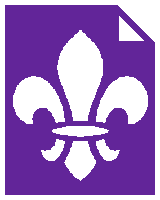How to Teach Semaphore
Scouts enjoy learning this visual communication method
The best way is to have them hold the flag by the handle, right close to the flag, with the index finger extended along the handle toward the top of the flag. With the handles in line with the forearms, you can then tell if he's sending an "H" or a "I" etc. Show them that whenever a flag needs to be held straight up above the head (as the letter "D") you do this by swinging the arm across in front of you so that the elbow is shoulder high, and right in front of your face. The forearm is pointed straight up with the index finger pointing up along the length of the handle. This will be required in the letters "D", "J", "K", "P", "V" and "Numerical".
The next lesson is to teach them that the flag when at 3:00 or 9:00 o'clock, must be held parallel to the deck (floor) so that it's not confused with 45° up or 45° down. The farther the distance being transmitted/sent, the more critical it is that positioning of the flags be exact.
Now that they have all been taught the proper way to hold the flags, break them up into groups of 4 (2x2). (At this point, if you are using the Patrol System, I would suggest that your first teams should be your PLs and 2nds. Take them aside, even on a different night, or the weekend, and teach them so they can teach their Patrols.) Each two Scout team has a "sender" and a "reader" (they'll take turns later). Start by teaching only the first Circle (A through to G).
How many three letter words can you make up with the first Circle? Try: bad, bed, cab, cad, fag, fed, gad, deb. Print out lists of these words for each group. From across the hall, street, playing field, park, etc. let the "reader" call out the letters to the "sender" and have the "sender" send to the other team in their group, then switch. Both members on the receiving end are now "readers". This should take up most of the night but by the end, they should all have a working knowledge of the first Circle.
The most important thing about both Semaphore and Morse Codes, is the ability to read, not to send. If the sender is sending faster than the reader can read, then what's the point of sending in the first place? After a while you can start to stress rhythm or cadence.
Next week, you can do the same with the second circle (H through to N). Now you will notice that for some reason, they step away from the logical sequence and the letter "J" is totally out of sequence. This is just something that they will have to remember. On the second circle, I would suggest that the first half of the list of three letter words be made up mostly of the second circle, then you can introduce three letter words that include both the first and second Circles. Continue this each week, dealing with one circle at a time.
Learning them in this order will assist them to recognize them both as "sender" and "reader" because although there seems to be no logic in the alphabetical sequences near the end, they tend to make more sense visually. And after all Semaphore is a "visual" form of communication. As they progress through the circles you can lengthen the words. In the beginning it is best not to have them transmit text because they will start to guess at what the word is if it is in a logical sequence. This is fine later on, but the fundamentals are the fundamentals.
When they start getting a little bit cocky, you can shake them up a bit by slipping in some random numbers, such as "THE ARM <Numerals> 3 7 <Alpha> ARE". This will throw them off and in so doing should help to "imprint" the numerals sign. Once you get them outside and some distance away so they can't yell back and forth, you'll see that it really starts to be fun.
Don't forget to give points toward the Honour Patrol for the most correct answers. Then watch the competitive spirits surface.
If anyone should suggest that it's out of date, you can tell them that the Royal Canadian Navy requires that every Seaman learn it before he can get out of Fleet School. While it may have limited practical use, it is still the most intensive learning experience they will have in Scouting. If they are still having Camporees in your neighbourhood, I would suggest that you have them create a Signalling Trophy, and create some interest among the other Troops.
Special Codes
These letters have special meaning and are used to assist the communication.
- K: Ready to receive.
- Q: Not ready to receive.
- A: General Answer: used after each word to show that it has been received correctly.
- AR: End of Message.
- R: Message received correctly (answer to AR).
- GB :"Good-bye", used when station is going to close down.
See this chart of semaphore positions.
